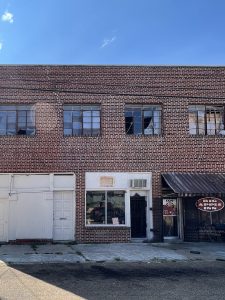As is appropriate, there have been many programs in the Jackson area celebrating or commemorating, what we refer to as Freedom Summer. Most of the events have been of excellent quality, informing or reminding thousands of what happened during that historic summer.
The program at the COFO Center on the campus of Jackson State University, however, is the focus of our attention because it wedded two different, but necessary, endeavors. Like most of the other programs, it presented the narratives, the stories of what happened during the summer of 1964. Like some other programs, it showcased research projects done on various aspects of, or efforts growing out of, the 1964 Summer Project. The Margaret Walker Center-sponsored program thus did both things.
From 11 a.m. until 12:45 p.m., the audience was exposed to the research of four scholars – Dr. Michelle Deardorff, Dr. Jeffrey Kolnick, Dr. Tiyi Morris, and Dr. Daphne Chamberlain. Prior to their presentations, however, Dr. Leslie McLemore, who served as the moderator, established the mood, or set the stage for the full program, the before noon and the after-noon segments.
Among the things to which he drew attention was that the effort in 1964 was a part of a historic struggle for voting rights. In order to dramatically bring home that point, he underscored statistics, events, and conditions in 1619, 1860, 1890, 1946, 1964, and more. His wide-ranging comments formed a background that demonstrated how African people were enslaved and brought to this country and state, without the power to vote or otherwise determine their own political fate, status, or destiny. The examples of terrorism, political violence, and Jim Crow laws and policies down through and including mass mis-education, the “White Primaries”, and the rules of the 1964 Democratic National Convention were explained as parts of the racist environment against which Black people have had to contend coming up to the 1964 Summer Project. He briefly described the development of the Council of Federated Organizations (COFO) and its manifestations – the Mississippi Freedom Democratic Party, the network of Freedom Schools, and the strategically located community centers – and the work they were designed to carry out. As he ended his comments and began introducing the researchers, he called upon the students and others in the audience to remember, celebrate and follow the examples of such 1964 warriors as Bob Moses, C.C. Bryant, Medgar Evers, Aaron E. Henry, Brenda Travis, and Jessie Morris.
The first scholar to speak as a part of the panel was Dr. Michelle Deardorff. Her research, which had grown out of the Freedom Summer movement, dealt with student protests. It was reflective of things that brought to mind the activities of Brenda Travis, Hollis Watkins, and others. Deardorff looked at student protests in Rolling Fork, Grenada, Meridian, and other local places, showing how the courts moved from a position of reluctance to recognize the students’ right to the position of placing a disruption test on such recognition and then finally to a position of deciding the students’ first amendment rights did not end at the schoolhouse door. Her overall conclusion was that the courts were moved to that position by the pressure of social movements such as Freedom Summer and the Vietnamese War. From there she commented on the implications of these realities in light of the current political environment, with its rhetoric and real examples of political violence on the part of many citizens.
The second presenter on the scholars’ panel was Dr. Jeffrey Kolnick. His research focused on how political events such as the 1964 Freedom Summer survive in popular memory. What he found was that too often people remembered what was emphasized by the popular media more so than what actually happened, or was of the greatest significance. He illustrated it with three examples.
(1) He discussed how the march on the Edmund Pettus Bridge is etched in peoples’ minds when they think of the Voting Rights Act, but they have little understanding or appreciation of the years of work done by the Dallas County Voting League, which had laid the groundwork.
(2) He pointed to how the appearance is often given that much more was done in Alabama than in Mississippi regarding civil rights because of the difference in media coverage.
(3) He talked about the fact that many more people know about Fannie Lou Hamer’s speech at the Democratic National Convention in 1964 than about the nature and significance of the compromise that was offered to the delegates from the Mississippi Freedom Democratic Party. From the comments about the all-white delegates at the convention understanding the nature of the compromise and deciding to then leave the Democratic Party, one could clearly understand how and why white Democrats across the old Confederate states changed and became Republicans.
Dr. Tiyi Morris, the daughter of civil rights veteran Jessie Morris, was the third presenter. Her research was on the alignment of Black women activism and the Freedom Summer Project. She discussed giants of the movement, such as Victoria Gray, Annie Devine, and Fannie Lou Hamer and the roles that they played in COFO and the Mississippi Freedom Democratic Party. But one of her early pointers was emphasizing that democratic policies and decision-making is not and has not always been synonymous with the Democratic Party, creating the need for voices like Mrs. Ineva May Pittman. She then quickly pivoted to assert that it was as a result of these Black activists that there was a 38% increase in the number of Black female elected officials in America. She closed by pointing to the spill-overs that undergirded the “Me, Too” movement and the re-assertion of the women’s reproductive health initiatives.
Dr. Daphne Chamberlain closed out the research-reporting segment of the program. Her research focused on the involvement of young, relative contemporary, activities. In particular, she gave firsthand information on the Mississippi Student Union, led by Rosanne Jones in 1964, which held its earliest convention at Tougaloo College in 1965. She pointed out that the union continues to function in Panola County, Meridian, Rolling Fork, Indianola, and other places around the state. It is active in protesting the negative conditions in education and is reminiscent of the Black Power and Black Pride movements. By highlighting the protest and arrest of Lanier student Elport Chess in 1946, she demonstrated that student activism is not a new phenomenon. The clinching statement with which she left the audience was that “young people have the power to create change.”
After lunch, the program turned attention to an impressive array of veterans of COFO and the 1964 Freedom Summer Project. Invited to make presentations were Dr. Leslie McLemore of Walls, who had been a student leader at Rust College; Dr. Joyce Ladner of Hattiesburg, who had been a student leader at Tougaloo College; MacArthur Cotton of Attala County, who had been a student leader at Tougaloo College; Euvester Simpson of Itta Bena; Jacqueline Byrd Martin of McComb; and Charles McLaurin, who worked out of Sunflower County. Rims Barber, who came to Mississippi for the 1964 project, and Jan Hillegas, who arrived shortly after COFO was established, were invited to add to the narrative as the events constituting the project were discussed.
Although the audience was encouraged to “Google” the names of the individuals mentioned as players in the 1964 Freedom Summer Project, those on the program did a masterful job in providing eye-witness accounts of the historic events. They also helped people to feel the history by graphically describing their plans and activities, the dangers and the threats that they faced, and their confrontations with state and local officials. The audience got a chance to hear about the difficulties faced in trying to organize the masses of Black residents on both plantations and in small towns. The things that they discussed were especially the things that were outside the coverage of the mainstream media. The media had reported on the testimonies before the Democratic officials, the disappearance and finding of the murdered civil rights workers, and the various marches. But these heroes took people behind the scenes to see more of the full truth.
This phase of the program was informative to many in the audience, especially students and out-of-state researchers. At the same time, it was quite moving for those who were not neophytes. Furthermore, it helped give meaning and urgency to the research that is on-going and the research that is still needed and may not have been initiated thus far.







